Scientific symbiosis
Kindschi Hall of Science provides state-of-the-art STEM learning and teaching environment
by Matthew Makowski
photos by Amanda Pitts
At a time when there is an increasing demand for careers in science, technology, engineering, mathematics (STEM), and health sciences across the U.S., Grand Valley’s new P. Douglas Kindschi Hall of Science offers students unique academic opportunities to study and excel in these fields.
Grand Valley currently offers 86 undergraduate programs and 36 graduate programs with more than 40 of them touching the STEM and health sciences in some capacity. The P. Douglas Kindschi Hall of Science is a construction partnership between the State of Michigan and Grand Valley. The state considered STEM and health-related programming as funding priorities. So did the more than 400 donors who supported the College of Liberal Arts and Sciences Margin of Excellence and Science Endowment Fund that brought the building to life.
Neil MacDonald, professor and chair of biology, said the 151,720 square-foot building came to fruition because enrollment in the university’s science and health programs has been steadily growing.
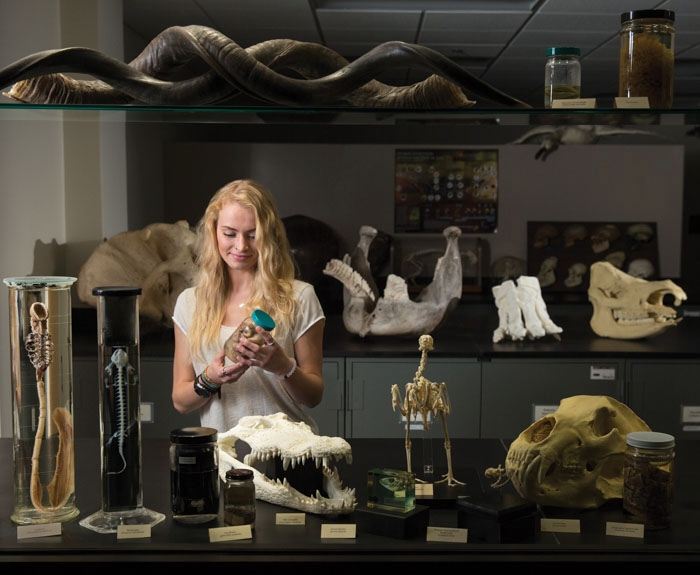
Jessica Vogt examines a specimen in the Zoology Preparation Area on the first floor of the building. Zoological specimens are stored and displayed for use in animal biology courses. The room is also designed as a public display case for passersby.
“The demand for all the science programs has been growing dramatically over the last 20 years, while the existing spaces in the Padnos Hall of Science and Henry Hall were increasingly hard-pressed to satisfy the demand for science courses,” MacDonald said.
MacDonald said this demand, however, does not solely come from students majoring in the sciences. The new facility will also be home to many general education and introductory science courses taken by students of all majors.
“At a university dedicated to liberal education, all Grand Valley students need this facility,” said Fred J. Antczak, dean of the College of Liberal Arts and Sciences. “We need scientists, but are better off having scientists who can reason about the whole social picture. We need humanists, but are better off having humanists, business people, social workers and grade school teachers who understand science and technology.”
Shared functionality
Mark Staves, professor of cell and molecular biology and department chair, said the 15 teaching laboratories and 14 faculty and student research laboratories in the four-story science hall will better prepare students after graduation.
“Students will benefit because we will be able to offer more sections of some classes that routinely fill up early, and they will have greater opportunities for carrying out the practice of science with faculty in research spaces,” Staves said. “This practical experience is often the difference between getting a job or position in graduate school, or not getting it.”
MacDonald added that these facilities were designed for a wide range of scholarly activities that will allow faculty members and students from biology, cell and molecular biology, biomedical sciences, movement science and other disciplines to work more collaboratively.
“These labs provide the physical space necessary for students to engage in a variety of scholarly projects with faculty, building on existing efforts while allowing for a future expansion of the scope of the research projects that can be pursued effectively in specifically designed laboratory spaces,” he said.
This improved collaboration is possible in the laboratories through the concept of “shared functionality,” which features shared instrumentation along the walls and flexible workbenches in the middle, allowing students and faculty to share space and equipment while researching.
“Lab work will be conducted in specifically designed laboratories that allow students to work in groups while also being able to interact closely with their laboratory instructors,” MacDonald said. “Lecture sections will be held in case rooms, which allows for greater interaction between students and instructors in a physically engaging space.”
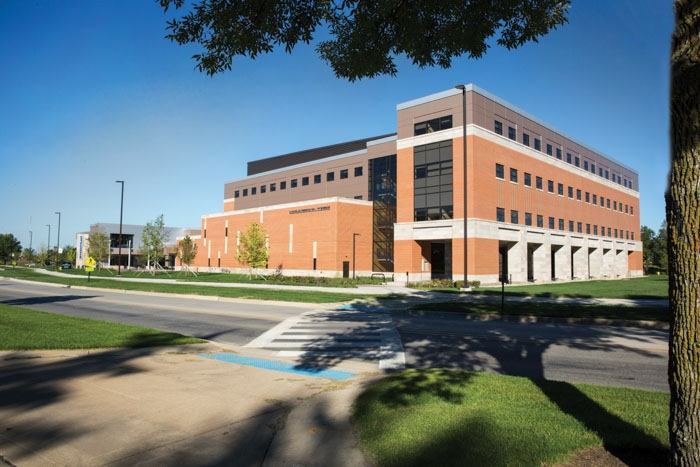
The P. Douglas Kindschi Hall of Science opened to students in August.
These types of scholastic activities and research will also be facilitated in the new 3,000 square-foot Barbara Kindschi Greenhouse, which can be divided into six different microclimates by one of the most advanced greenhouse control systems available.
Gary Greer, professor of biology, said the greenhouse’s larger overall size, individual rooms and compartments, and advanced climate control systems allow for teaching and research projects that were not feasible in the Padnos Hall of Science greenhouse. The expanded spaces within the Kindschi Hall of Science will also increase elasticity for scheduling courses.
“The new spaces will provide increased flexibility for all science units to schedule their courses during times that work for students, allowing them to develop weekly schedules that better mesh with co-curricular activities, off-campus work or family responsibilities,” Antczak said.
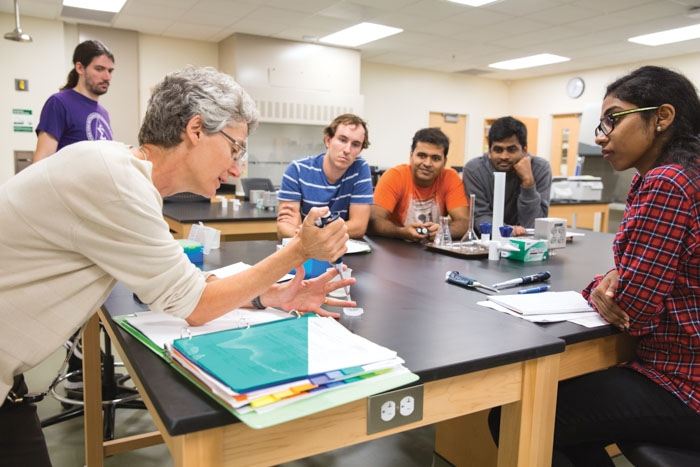
Flexible workbenches allow students and faculty members to share space and equipment while working on research projects.
James Moyer, associate vice president for Facilities Planning, said that above all else, the Kindschi Hall of Science is designed to help students, faculty and staff members, and visitors see the scientific world in a different light.
“Science is all around us and one interacts with science without a second thought. When something is brought to our attention as a science, we can become more aware of it,” he said.
“For instance, we appreciate rain for what it is and yet, as a factor in the study of erosion, rain assumes an entirely different personality.”
The art of science
When Grand Valley constructs a new academic building, the Galleries and Collections team selects diverse artwork from its collection of more than 13,000 pieces to tell visual stories that are applicable to both faculty and students.
Cathy Marashi, assistant director of Galleries and Collections, said the more than 460 works of art within the Kindschi Hall of Science not only personify the spirit of the building, but also the curriculums students practice within.
“It’s a really interesting building because the subject matter is fascinating and lends itself to visual pieces,” Marashi said. “It includes visual representations of the biology of the sea, the flora and fauna of the Earth, the environment, climate changes and everything in outer space.”
While the team has historically only needed artwork for corridors, Marashi added that the vast size of the classrooms within the Kindschi Hall of Science presents new opportunities for displaying art. Classrooms and lecture halls have themes ranging from rainforests, cellular imaging and environmental and climate changes, to endangered species and even the Grand River.
“Not only will students be exposed to the underlying science in the classroom, but in the hallways they will see artistic representations related to the topics they are studying in class — providing another way of looking at natural phenomena,” MacDonald said. “Many of the artistic representations on display are also linked less directly to specific scientific topics, encouraging students and faculty to think of the scientific endeavor in a much broader context.”
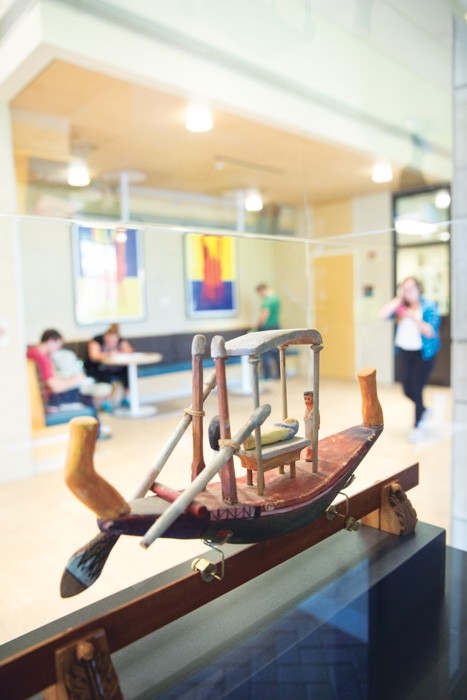
Artwork enhances the atmosphere of the building and is carefully selected by the Galleries and Collections team around the broad theme of the sciences.
Designed destination
Students will not only benefit from the academic resources within the functional and environmentally friendly building, but they will also benefit from the non-academic perks connected to the new building. These include The Marketplace, which houses the 45,000 square-foot, two-story GVSU Laker Store (formerly the University Bookstore), Starbucks and Which Wich Superior Sandwiches, a made-to-order sandwich shop.
The project’s scope was eventually expanded to include these non-academic locations, along with eight study spaces within the Kindschi Hall of Science, to create an overall multi-purpose destination for students to interact on campus.
“Students learn together and we hear from various sources that the few minutes after a class where students engage with each other is very important,” Moyer said. “By providing student study spaces, we provide the opportunity for engagement.”
Building namesake brings four decades of service to Grand Valley
It is very fitting that our newest science building should be named in honor of P. Douglas Kindschi. Dr. Kindschi has generously supported the endowed funds that brought the building to life. He has served the university for nearly 40 years in many different capacities and is currently the director of the university’s Sylvia and Richard Kaufman Interfaith Institute.
Dr. Kindschi was Dean of Science and Mathematics where he helped build the foundation for the science and mathematics programs at Grand Valley. He was influential in the creation of some of the university’s nationally recognized academic programs in the science and health fields, including the Seymour and Esther Padnos College of Engineering and Computing and the Robert B. Annis Water Resources Institute, and he led the effort to build the Seymour and Esther Padnos Hall of Science.
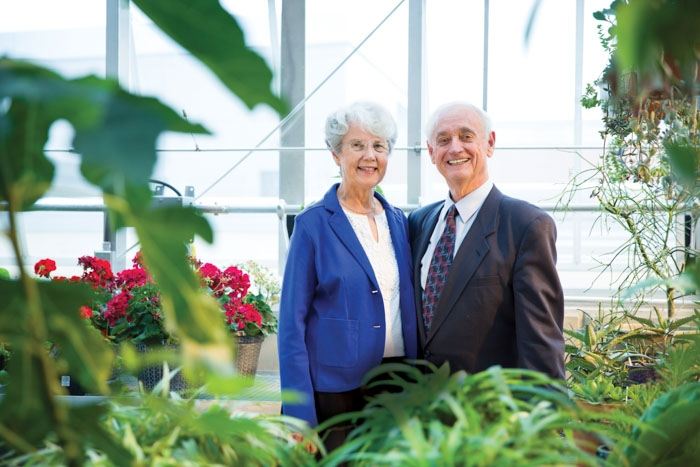
Barbara and Doug Kindschi are pictured in the Barbara Kindschi Greenhouse.
Dr. Kindschi has been actively engaged with elementary and secondary students in science education through his establishment of the Coalition for Excellence in Science and Math Education, the Regional Math and Science Center, and Science Olympiad tournaments, which give thousands of area middle and high school students the opportunity to develop their talents in the STEM fields.
The Kindschis both have a commitment to Grand Valley science programs. Barbara Kindschi hopes to share her passion for horticulture with students through her support for the Barbara Kindschi Greenhouse, a 3,000 square-foot greenhouse within the Kindschi Hall of Science with tropical, arid, temperate, and quarantine bays for research and teaching.
New greenhouse plants seed for continued teaching, learning
by Leah Twilley
A 3,000 square-foot greenhouse in the P. Douglas Kindschi Hall of Science will provide a copious amount of space for faculty members and students to grow through education and research.
The Barbara Kindschi Greenhouse, located on the second floor, has six growing bays that use an advanced controlling system to maintain specific climates from environments around the world. It houses the university’s established greenhouse collection, which includes nearly 300 species that represent major plant groups found in tropical, temperate and arid environments.
The space is named in honor of Barbara Kindschi, wife of former dean and longtime faculty member Doug Kindschi. She said her love of plants, trees and nature led her to support the new greenhouse.
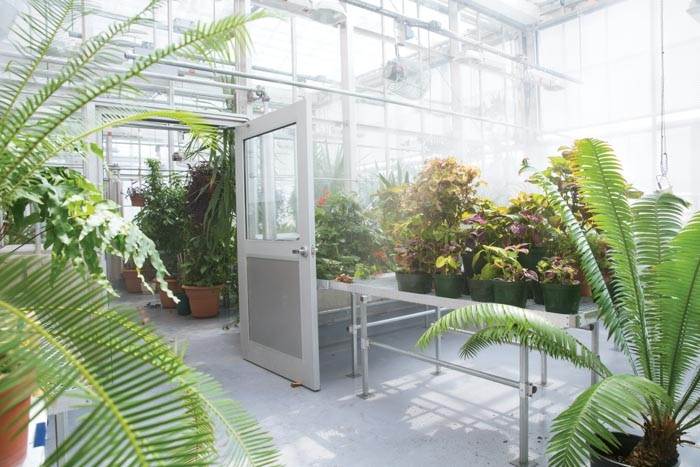
The Barbara Kindschi Greenhouse is divided into six growing bays with varying climates. An advanced controlling system allows specific environments to be maintained.
“When I first saw this magnificent greenhouse, I knew I wanted to support all the faculty and students who will be studying and working here by giving them further opportunities to understand and nurture plant life,” said Kindschi.
Neil MacDonald, chair of the biology department and professor of biology and natural resources management, was involved in the design and planning process for the greenhouse. He said the goal was to create a space that would be both a functional and attractive addition to the building for years to come.
“A major priority was to design a space that would properly control different environments,” said MacDonald. “If it gets too hot in the summer or too cold in the winter, you start to lose plants or they get damaged, so it’s important that we have a space where we can maintain an environment within a certain range of temperature and humidity for year-round teaching.”
The greenhouse will also include growth chambers for small projects that don’t require much space. On the outside, they look like large refrigerators; on the inside, plants grow in a controlled environment through the use of specific lighting, heating and humidity. The greenhouse not only serves students majoring in biology, but it helps meet the demand for a growing enrollment in the health sciences fields, where students often take introductory courses that use the space during laboratory sessions.
The former greenhouse, connected to the Seymour and Esther Padnos Hall of Science, was built in 1995. A growing student population and ever-expanding campus called for a bigger greenhouse, MacDonald said.
“If faculty wanted to do research, the lab supervisor had to shift around plants and make room in the former greenhouse,” said MacDonald.
The new space will house two bay areas specially configured for research and class projects, so the teaching collection will not be disrupted.
